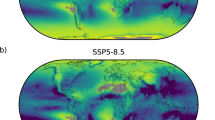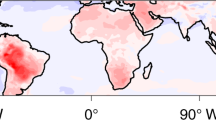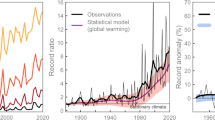Abstract
Many tropical countries are exceptionally vulnerable to changes in rainfall patterns, with floods or droughts often severely affecting human life and health, food and water supplies, ecosystems and infrastructure1. There is widespread disagreement among climate model projections of how and where rainfall will change over tropical land at the regional scales relevant to impacts2,3,4, with different models predicting the position of current tropical wet and dry regions to shift in different ways5,6. Here we show that despite uncertainty in the location of future rainfall shifts, climate models consistently project that large rainfall changes will occur for a considerable proportion of tropical land over the twenty-first century. The area of semi-arid land affected by large changes under a higher emissions scenario is likely to be greater than during even the most extreme regional wet or dry periods of the twentieth century, such as the Sahel drought of the late 1960s to 1990s. Substantial changes are projected to occur by mid-century—earlier than previously expected2,7—and to intensify in line with global temperature rise. Therefore, current climate projections contain quantitative, decision-relevant information on future regional rainfall changes, particularly with regard to climate change mitigation policy.
This is a preview of subscription content, access via your institution
Access options
Subscribe to this journal
Receive 12 print issues and online access
$209.00 per year
only $17.42 per issue
Buy this article
- Purchase on Springer Link
- Instant access to full article PDF
Prices may be subject to local taxes which are calculated during checkout




Similar content being viewed by others
References
IPCC Summary for Policymakers in Climate Change 2014: Impacts, Adaptation, and Vulnerability (eds Field, C. B. et al.) (Cambridge Univ. Press, 2014).
Collins, M. et al. in Climate Change 2013: The Physical Science Basis (eds Stocker, T. F. et al.) (Cambridge Univ. Press, 2013).
McSweeney, C. F. & Jones, R. G. No consensus on consensus: The challenge of finding a universal approach to measuring and mapping ensemble consistency in GCM projections. Climatic Change 119, 617–629 (2013).
Neelin, J. D., Munnich, M., Su, H., Meyerson, J. E. & Holloway, C. E. Tropical drying trends in global warming models and observations. Proc. Natl Acad. Sci. USA 103, 6110–6115 (2006).
Chadwick, R., Boutle, I. & Martin, G. Spatial patterns of precipitation change in CMIP5: Why the rich do not get richer in the tropics. J. Clim. 26, 3803–3822 (2013).
Kent, C., Chadwick, R. & Rowell, D. P. Understanding uncertainties in future projections of regional precipitation. J. Clim. 28, 4390–4413 (2015).
Mora, C. et al. The projected timing of climate departure from recent variability. Nature 502, 183–187 (2014).
Chou, C. & Neelin, J. D. Mechanisms of global warming impacts on regional tropical precipitation. J. Clim. 17, 2688–2701 (2004).
Held, I. M. & Soden, B. J. Robust responses of the hydrological cycle to global warming. J. Clim. 19, 5686–5699 (2006).
Seager, R., Naik, N. & Vecchi, G. A. Thermodynamic and dynamic mechanisms for large-scale changes in the hydrological cycle in response to global warming. J. Clim. 23, 4651–4668 (2010).
Chou, C., Neelin, J. D., Chao-An, C. & Jien-Yi, T. Evaluating the “Rich-Get-Richer” mechanism in tropical precipitation change under global warming. J. Clim. 22, 1982–2005 (2009).
Solomon, S., Plattner, G-K., Knutti, R. & Friedlingstein, P. Irreversible climate change due to carbon dioxide emissions. Proc. Natl Acad. Sci. USA 106, 1704–1709 (2009).
Liu, C. & Allan, R. P. Observed and simulated precipitation responses in wet and dry regions 1850–2100. Environ. Res. Lett. 8, 034002 (2013).
Durack, P. J., Wijffels, S. E. & Matear, R. J. Ocean salinities reveal strong global water cycle intensification during 1950 to 2000. Science 336, 455–458 (2012).
Xie, S.-P. et al. Global warming pattern formation: Sea surface temperature and rainfall. J. Clim. 23, 966–986 (2010).
Greve, P. et al. Global assessment of trends in wetting and drying over land. Nature Geosci. 7, 716–721 (2014).
Roderick, M. L., Sun, F., Lim, W. H. & Farquhar, G. D. A general framework for understanding the response of the water cycle to global warming over land and ocean. Hydrol. Earth Syst. Sci. 18, 1575–1589 (2014).
Rowell, D. P. Sources of uncertainty in future changes in local precipitation. Clim. Dynam. 39, 1929–1950 (2012).
Good, P. & Lowe, J. Emergent behaviour and uncertainty in multimodel climate projections of precipitation trends at small spatial scales. J. Clim. 19, 5554–5569 (2006).
Ackerley, D. et al. Sensitivity of twentieth-century Sahel rainfall to sulfate aerosol and CO2 forcing. J. Clim. 24, 4999–5014 (2011).
Rotstayn, L. D. et al. Have Australian rainfall and cloudiness increased due to the remote effects of Asian anthropogenic aerosols? J. Geophys. Res. 112, D09202 (2007).
Allen, M. R. & Ingram, W. J. Constraints on future changes in climate and the hydrological cycle. Nature 419, 224–232 (2002).
Giorgi, F. & Bi, X. Time of emergence (TOE) of GHG-forced precipitation change hot-spots. Geophys. Res. Lett. 36, L06709 (2009).
Bayr, T. & Dommenget, D. The tropospheric land–sea warming contrast as the driver of tropical sea level pressure changes. J. Clim. 26, 1387–1402 (2013).
Giannini, A. Mechanisms of climate change in the Semiarid African Sahel: The local view. J. Clim. 23, 743–756 (2010).
Fasullo, J. A mechanism for land–ocean contrasts in global monsoon trends in a warming climate. Clim. Dynam. 39, 1137–1147 (2012).
Seo, J., Kang, S. M. & Frierson, D. M. W. Sensitivity of intertropical convergence zone movement to the latitudinal position of thermal forcing. J. Clim. 27, 3035–3042 (2014).
Hwang, Y.-T., Frierson, D. M. W. & Kang, S. M. Anthropogenic sulphate aerosol and the southward shift of tropical precipitation in the late 20th century. Geophys. Res. Lett. 40, 2845–2850 (2013).
Cao, L., Bala, G. & Caldeira, K. Climate response to changes in atmospheric carbon dioxide and solar irradiance on the time scale of days to weeks. Environ. Res. Lett. 7, 034015 (2012).
Levine, R. C., Turner, A. G., Marathayil, D. & Martin, G. M. The role of northern Arabian Sea surface temperature biases in CMIP5 model simulations and future predictions of Indian summer monsoon rainfall. Clim. Dynam. 41, 155–172 (2012).
Kutzbach, J. E. & Liu, Z. Response of the African monsoon to orbital forcing and ocean feedbacks in the middle Holocene. Science 278, 440–443 (1997).
Harris, I., Jones, P. D., Osborn, T. J. & Lister, D. H. Updated high-resolution grids of monthly climatic observations-the CRU TS3.10 dataset. Int. J. Climatol. 34, 623–642 (2013).
Adler, R. F. The Version 2 Global Precipitation Climatology Project (GPCP) monthly precipitation analysis (1979-Present). J. Hydrometeorol. 4, 1147–1167 (2003).
Arid Zone Forestry: A Guide for Field Technicians Ch. 1 (FAO Corporate Document Repository, 1989); http://www.fao.org/docrep/t0122e/t0122e03.htm#chapter%20i.%20the%20arid%20environments
Mahli, Y. & Wright, J. Spatial patterns and recent trends in the climate of tropical rainforest regions. Phil. Trans. R. Soc. Lond. B 359, 311–329 (2004).
Acknowledgements
All authors were supported by the Joint UK DECC/Defra Met Office Hadley Centre Climate Programme (GA01101). We acknowledge the World Climate Research Programme’s Working Group on Coupled Modelling, which is responsible for CMIP, and we thank the climate modelling groups for producing and making available their model output. For CMIP the US Department of Energy’s Program for Climate Model Diagnosis and Intercomparison provides coordinating support and led development of software infrastructure in partnership with the Global Organization for Earth System Science Portals. We thank G. J. van Oldenborgh for making the CMIP5 data easily available via the KNMI Climate Explorer tool.
Author information
Authors and Affiliations
Contributions
R.C. conceived the original idea for the study, and performed the analysis. All authors provided additional ideas, helped to refine the methodology, and contributed towards writing the manuscript.
Corresponding author
Ethics declarations
Competing interests
The authors declare no competing financial interests.
Supplementary information
Rights and permissions
About this article
Cite this article
Chadwick, R., Good, P., Martin, G. et al. Large rainfall changes consistently projected over substantial areas of tropical land. Nature Clim Change 6, 177–181 (2016). https://doi.org/10.1038/nclimate2805
Received:
Accepted:
Published:
Issue Date:
DOI: https://doi.org/10.1038/nclimate2805
This article is cited by
-
Significantly wetter or drier future conditions for one to two thirds of the world’s population
Nature Communications (2024)
-
Natural disasters related to rainfall trends in Espírito Santo, southeastern Brazil
Theoretical and Applied Climatology (2024)
-
Integrated changes in tropical precipitation and circulation under global warming: moist static energy budget and the role of sea surface warming pattern
Climate Dynamics (2023)
-
Different rootstocks can change the photosynthetic performance of the ‘Uba’ mango scion after recurrent drought events
Trees (2023)
-
A teleconnection study between oceanic oscillations and trends in precipitation extremes in the Paraíba do Sul River Basin
Theoretical and Applied Climatology (2023)



